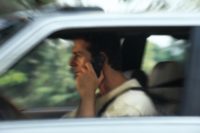Motor vehicle crashes are consistently the leading cause of death among workers in the U.S., according to the Centers for Disease Control and Prevention (CDC). There were 18,716 work-related crash fatalities between 2003
and 2012.
Employers bear the cost for motor vehicle injuries that occur both on and off the job, says OSHA. Whether you manage a fleet of vehicles, oversee a mobile sales force or simply employ commuters, implementing a driver safety program in the workplace reduces the risks faced by your employees and their families while protecting your company’s bottom line.
Implementing a program
OSHA says your safe driving program should work to keep the driver and those with whom he or she shares the road safe. If necessary, the program must work to change driver attitudes, improve behavior, and increase skills to build a “be safe” culture.
On its website at https://www.osha.gov/Publications/motor_vehicle_guide.html, the agency outlines the following ten steps for building a driver safety program in your workplace:
1) Senior Management Commitment & Employee Involvement
2) Written Policies and Procedures
3) Driver Agreements
4) Motor Vehicle Record (MVR) Checks
5) Crash Reporting and Investigation
6) Vehicle Selection, Maintenance and Inspection
7) Disciplinary Action System
8) Reward/Incentive Program
9) Driver Training/Communication
10) Regulatory Compliance
Following these steps, the agency says, will help employers improve traffic safety performance, minimize the risk of motor vehicle crashes, hire capable drivers and only allow eligible drivers to drive on company business, train and supervise drivers, maintain company vehicles properly, and help minimize motor vehicle insurance costs.
Company or personal car – makes no difference
OSHA says these steps will be useful to any organization regardless of its size, type of traffic encountered, number of vehicles involved, or whether employees drive company or personal vehicles for work purposes. Also included in OSHA’s guide are real-life examples of successful safety programs, key traffic safety issues to address in the workplace, instructions for calculating your organization’s loss from motor vehicle crashes, and a list of resources to help you fine-tune your program.
NIOSH checklist
Another resource is a new fact sheet from the National Institute for Occupational Safety and Health. “Prevent work-related motor vehicle crashes” recommends ways employers can keep workers safe when driving or riding in a motor vehicle on the job. It outlines components of a successful motor vehicle safety program and ends with a checklist that employers can use to implement the recommendations. Access it at www.cdc.gov/niosh/docs/2015-111/pdfs/2015-111.pdf.
Defining distraction
A crucial part of your driver safety program is addressing distracted driving. Each day in the U.S., more than 9 people are killed and more than 1,153 people are injured in crashes reported to involve a distracted driver, says the CDC. In 2012, 3,328 people were killed in crashes involving a distracted driver. Employers need to develop a workplace distracted driving policy and teach workers how to minimize or eliminate potential driving distractions.
The National Highway Traffic Safety Administration (NHTSA) defines distraction as “any activity that could divert a person’s attention away from the primary task of driving.” Distractions are classified into three categories: visual, manual or cognitive. In other words, anything that takes a driver’s eyes off the road, hands off the wheel, or mind off of driving.
• Manual distractions are those where you move your hands away from the task of controlling the vehicle; for example, reaching for a drink.
• Visual distractions occur when you focus your eyes away from the road – to glance at a road map, for instance.
• A cognitive distraction means your mind wanders away from the task of driving. Engaging in an intense conversation with a passenger in your vehicle can cause a cognitive distraction.
Texting involves all three types of distractions at the same time. Other examples of distractions include using a cell phone or smart phone (including texting), eating and drinking, smoking, attending to or disciplining child passengers, grooming, reading (including maps), using a navigation system, watching a video, adjusting a radio, CD player or MP3 player or adjusting temperature controls.
Tips for avoiding driving distractions
When instituting a distracted driving policy, consider the following ideas for managing distractions:
- Turn your phone off or switch it to silent mode before you get in the car. Then stow it away so it’s out of reach.
- Record a message on your phone that tells callers you’re driving and will get back to them when you’re off the road, or sign up for a service that offers this feature.
- If you need to make a call, pull over to a safe area first.
- Ask a passenger to make the call or respond to a text for you.
- Don’t ever text and drive, surf the web or read your email while driving. It’s dangerous and against the law in most states. Even hands-free and voice-to-text features aren’t risk-free.
- Familiarize yourself with state and local laws before you get in the car. Some states and localities prohibit the use of hand-held cell phones in addition to texting.
- Finish dressing and personal grooming at home – before you get on the road.
- If using a GPS device, enter your destination before you start to drive. If you prefer a map or written directions, review them in advance. If you need help while driving, ask a passenger to assist you or pull over to a safe location to change your GPS or review your map/directions.
- Adjust vehicle systems such as seats, mirrors, climate controls and sound systems before hitting the road.
- If possible, eat meals or snacks before or after your trip, not while driving. On the road, avoid messy foods that can be difficult to
- manage.
- Secure your pets. Unsecured pets can be a big distraction in the car.
- Pull over to a safe place to address situations involving children in the car.
- Store loose gear, possessions and other distractions that could roll around in the car, so you do not feel tempted to reach for them on the floor or the seat.
- Focus on driving – Do not let anything divert your attention, actively scan the road, use your mirrors and watch out for pedestrians and cyclists.
Sources: AAA and The Governors’ Highway Safety Association



